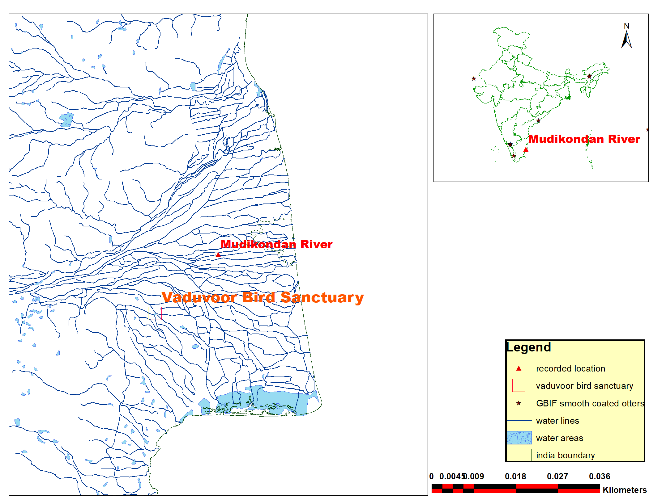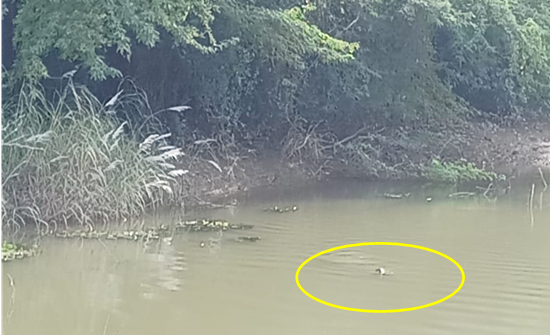IUCN/SSC Otter Specialist Group Bulletin

©IUCN/SCC Otter Specialist Group
Volume 36 Issue 2 (April 2019)
Citation: Chackaravarthy, SD, Kamalakannan, B and Lakshminarayanan, N (2019).The Necessity of Monitoring and Conservation of Smooth-Coated Otters (Lutrogale perspicillata) in Non-Perennial Rivers of South India. IUCN Otter Spec. Group Bull. 36 (2):83 - 87
The Necessity of Monitoring and Conservation of Smooth-Coated Otters (Lutrogale perspicillata) in Non-Perennial Rivers of South India
Sampath Deepan Chackaravarthy, Balasubramanian Kamalakannan and Natarajan Lakshminarayanan
Wildlife Institute of India, Post Box # 18, Chandrabani, Dehradun 248001, India. E-mail: smdeepan84@gmail.com
Received 25th January 2019, accepted 26th April 2019
Abstract: Perceptions of Smooth-Coated Otters are different in the various areas of their distribution. In some parts of the world, the species is regarded as deities, while in others parts they have been loathed as vermin. Smooth-coated Otters have the widest distribution of otter species in the Indian sub-continent, but face both lack of information and lack of attention for conservation. As the distribution of this top carnivore species depends on semi-aquatic habitat, it faces immense threats. In particular, groups or families that inhabit non-perennial river systems face severe threats and are currently data deficient. We have recorded one such active family of Smooth-coated Otter on a non-perennial river system: the River Cauvery in south India. There is a strong need to take steps to study and conserve for the population inhabiting areas like this. The IUCN Otter Specialist Group also emphasize the need for good fundamental ecological research for every single species of otter.
Keywords: Lutrogale perspicillata, Putrajaya Lake & Wetland, man-made wetlands, aquatic mating, breeding season, breeding biology
INTRODUCTION
Otters are semi-aquatic mammals belonging to sub-family Lutrinae within the family Mustelidae. They are often closely associated with riparian habitats and marine systems (Prakash et al, 2012). Otters occur on five out of seven continents of the world, excluding Australia and Antartica. Otters play a significant role in ecosystems as both carnivores and meso-carnivores occupying important positions in foodwebs (Roemer et al, 2009). In systems where top carnivores are scarce, such as riparian ecosystems, meso-carnivores like otters play a crucial role in the food web and community stability by exerting top-down control on their prey species (Roemer et al, 2009). Loss of meso-carnivores like otters could lead to trophic cascade and other devastating effects on ecological communities (Estes et al, 2011). Notwithstanding their crucial role in the ecosystem, ironically, many species of otters have been witnessing massive range and population declines (Gomez and Bouhuys, 2018). The IUCN has categorized seven out of 13 extant species of otters on the globe as endangered. The greatest threats facing otters are habitat loss, depletion of fish and other prey (Anoop & Hussain, 2004) and direct hunting for their pelts (Duckworth & Hill 2008, Shepherd and Nijman 2014).
Considering their endangered status, there is an urgent need to formulate conservation strategies to secure remnant otter populations across their range (Hussain and Choudhury, 1997). Even simple indices such as occupancy and distribution of otters would be hugely helpful in conservation planning. While systematic distribution surveys are crucial, it is also important to report verified presence of otters in “new” areas from observations etc. from ‘new’ areas, and for these to be followed up with proper surveys. This approach is particularly relevent in the case of species such as the smooth-coated otter (Lutrogale perspicillata), whose range falls largely outside designated protected areas in India.
The smooth-coated otter is one of the many otter species listed as vulnerable, as their populations have reportedly suffered over 30% decline during the last 30 years (Pacifici et al., 2013; Shenoy et al., 2006). Smooth-coated otters are highly social and form large family parties to feed on fishes, shrimps, crustaceans, oysters, invertebrates and even birds (Duplaix and Savage, 2018). They occur in a range of habitats that include placid waters, even paddy fields, and floodplains along large river systems, lakes, peat swamp forests, mangroves and estuaries (Melisch and Foster-Turley, 1996). Smooth-coated otters have a wide distribution in India. However, systematic assessment of their habitat and populations is scarce (Hussain and Choudhury, 2007). Natural history observations suggest that smooth-coated otters require thick riverine vegetation to hide, make dens and raise their young, so their habitat occupancy depends on such dense riverine vegetation, protection from disturbance and prey availability.
Recently, in January 2019, we recorded a group of smooth coated otters in the River Mudikondan (Fig. 1 and 2), which is a non-perennial distributary of the River Cauvery flowing for about 50 km from its source to the coast.

Like the River Mudikondan, there are many other distributaries of River Cauvery, most of which are non-perennial and flow only during the release of water from the major reservoirs built upstream in the large river, during the period from June to January. The flow in these distributaries is highly regulated by dams and weirs. In addition to the sighting record that we report here, there is also a plethora of secondary information on sightings of smooth-coated otters reported from other distributaries in the region. For example, quite recently, Kolappan (2018) reported the presence of smooth-coated otters in the Vaduvoor Bird Sanctuary (a Protected Area), which is around 30 km from the site that we report on in this article.
It is noteworthy that according to the Global Biodiversity Information Facility (GBIF), smooth-coated otters were not reported from any of the distributaries of the River Cauvery, and our reporting thus assumes significance. The site where we recorded the presence of smooth-coated otters in this article is unprotected, as is the case for most of the distributaries of the Cauvery river system. There is, therefore, an urgent to study, monitor and conserve these fragile populations, before these habitats further shrink and fish stocks deplete (Duplaix and Savage, 2018) making the river unsuitable for supporting otters. It is widely believed by the scientific community that the decline of otter species may be occurring more rapidly that it is generally perceived and thus, ex-situ conservation strategies are increasingly being recommended (IUCN Otter Specialist Group).
REFERENCES
Anoop, K.R., Hussain, S.A. (2004). Factors affecting habitat selection by smooth-coated otters (Lutra perspicillata) in Kerala, India. Journal of Zoology, 263(4): 417–423. https://doi.org/10.1017/S0952836904005461
Chanin, P. (2003). Ecological requirements of the European otter Lutra lutra. Conserving Natura 2000 Rivers Ecology Series No. 10. English Nature, Peterborough.
Duplaix, N., Savage, M. (2018). The Global Otter Conservation Strategy. IUCN/SSC Otter Specialist Group, Salem, Oregon, USA
Duckworth, J.W., Hills, D.M. (2008). A specimen of Hairy-nosed Otter Lutra sumatrana from far northern Myanmar. IUCN Otter Spec. Group Bull 25(1): 60-67.
Estes, JA, Terborgh J, Brashares JS, Power ME, Berger J, Bond WJ, Carpenter SR, Essington TE, Holt RD, Jackson JBC, Marquis RJ, Oksanen L, Oksanen T, Paine RT, Pikitch EK, Ripple WJ, Sandin SA, Scheffer M, Schoener TW, Shurin JB, Sinclair ARE, Soule ME, Virtanen R, Wardle DA. (2011). Trophic Downgrading of Planet Earth. Science. 333: 301-306
Foster-Turley, P. (1992). Conservation aspects of the ecology of Asian small-clawed and smooth-coated otters on the Malay Peninsula. IUCN Otter Spec. Group Bull 7: 26–29.
Gomez, L., Bouhuys. J. (2018). Illegal otter trade in Southeast Asia. TRAFFIC, Petaling Jaya, Selangor, Malaysia.
Hussain, S.A., Choudhury, B.C. (1997). Status and distribution of smooth-coated otter Lutra perspicillata Geoffroy (Carnivora, Mustelidae) in National Chambal Sanctuary, India. Mammalia. 60: 289-297.
Kolappan, B. (2018). River otters show up in Vaduvoor lake https://www.thehindu.com/news/national/tamil-nadu/river-otters-show-up-in-vaduvoor-lake/article25415226.ece (accessed on 24th January 2019).
Melisch, R., Foster-Turley, P. (1996). First record of hybridisation in otters (Lutrinae: Mammalia), between smooth-coated otter, Lutrogale perspicillata (Geoffroy, 1826) and Asian small-clawed otter, Aonyx cinerea (Illiger, 1815). Der Zoologische Garten. 66: 284–288.
Pacifici, M., Santini, L. Di Marco, M., Baisero, D., Francucci, L., Marasini, G.G., Visconti, P., Rondini, C. (2013). Generation length for mammals. Nature Conservation, 5: 89-94.
https://natureconservation.pensoft.net/article/1343/ (accessed 4th July 2019)
Prakash, N., Mudappa, D., Shankar Raman, T.R, Kumar, A. (2012). Conservation of the Asian small-clawed otter (Aonyx cinereus) in human-modified landscapes, Western Ghats, India. Tropical Conservation Science 5(1):67-78.
Prater, S.H. (1993). The Book of Indian Animals. Fourth impression, Bombay Natural History Society, Oxford University Press, Mumbai, India. pp. 324.
Roemer, G, Gompper, ME and Van Valkenburgh, B (2009). The Ecological Role of the Mammalian Mesocarnivore. BioScience. 59: 165-173. https://doi.org/10.1525/bio.2009.59.2.9
Shenoy, K., Varma, S., Prasad, K.V.D. (2006). Factors determining habitat choice of the smooth-coated otter, Lutra perspicillata in a South Indian river system. Current Science. 91: 637-643
Shepherd, C.R., V. Nijman. (2014). Otters in the Mong La wildlife market, with a first record of hairy-nosed otter Lutra sumatrana in trade in Myanmar. IUCN Otter Spec. Group Bull 31(1): 31-34.
Résumé : Nécessité de Monitorer et Protéger les Loutres à Pelage Lisse (Lutrogale perspicillata) dans les Rivières Intermittentes du Sud de l’Inde
La perception des loutres à pelage lisse est différente selon les zones de répartition. Dans certaines parties du monde, l’espèce est considérée comme une divinité, alors que dans d’autres, elles ont été détestées comme la vermine. Les loutres à pelage lisse ont la plus large distribution dans l'aire de répartition du sous-continent indien, mais elles font face à la fois au manque d'informations et au manque d’attention porté à leur conservation. Étant donné que la distribution de cette espèce top carnivore dépend d'un habitat semi-aquatique, elle fait face à des menaces immenses. En particulier, le groupe ou famille qui habite les systèmes fluviaux intermittents est confronté à une menace grave et au manque de données. Nous avons observé une telle famille active de loutre à pelage lisse issue d’un système fluvial intermittent de la rivière Cauvery, dans le Sud de l’Inde. Il est urgent de prendre des mesures pour étudier et protéger la population vivant dans cet habitat. Le groupe de spécialistes des loutres de l’UICN souligne également la nécessité d’une bonne recherche écologique fondamentale sur chaque espèce de loutre.
Revenez au dessus
Resumen: Necesidad de Monitorear y Conservar la Nutria Lisa (Lutrogale perspicillata) en Ríos no-permanentes del Sur de India
Las percepciones sobre las Nutrias Lisas son diferentes en distintas áreas de su distribución. En algunas partes del mundo, la especie es una deidad, mientras que en otras han sido detestadas como plagas. Las Nutrias Lisas tienen su distribución más amplia en el sub-continente Indio, pero se enfrentan tanto a una falta de información como de atención para su conservación. Como la distribución de este carnívoro tope depende de hábitats semi-acuáticos, enfrenta inmensas amenazas. En especial, los grupos o familias que habitan los sistemas de ríos no-permanentes enfrentan severas amenazas, y son deficientes en datos. Hemos registrado una de tales familias activas en un sistema de ríos no-permanentes vinculado al río Cauvery, sur de India. Hay una necesidad extrema de dar pasos para estudiar y conservar la población que vive en este hábitat. El grupo de especialistas en nutrias de la UICN, también, enfatiza la necesidad de buena investigación ecológica básica en todas las especies de nutria.
Vuelva a la tapa



